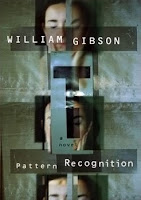.jpg)
William Gibson's latest novel, Pattern Recognition, is finally out. He's done something I always wanted to do but never figured out how to do: write an SF novel set in the present as-it-is.
The angry young punk who wrote Neuromancer seems to have calmed down a bit. PR has its fair share of nasty people, but there's a humanistic glow around it. Gibson is starting to like his characters. You could even accuse him of having a heart. The Pynchon influence still shines like Byron the Bulb on every page.
The plot concerns Cayce Pollard, a woman with a talent for pattern recognition. Her brain knows if a logo is going to move the masses. The price she pays; certain mass marketing graphics give her panic attacks. Especially the Michelan Man.
She's hired to track down the mysterious author of the Footage, a film appearing in dribs and drabs on the Internet with no acknowledged author and expertly erased tracks. Along the way, Pollard tracks down the wheels-within-wheels of multilayered conspiracies that touch on the Russian mafia, product placement, social marketing and the death of her father in 9-11. The overall effect is an Alice in Wonderland tumble into deeper and deeper weirdness. The obvious Pynchon comparison here is The Crying of Lot 49.
The footage author turns out to be a young Russian filmmaker suffering brain damage from the bomb that killed her parents -- high-up figures in the Russian mob hierarchy. The code that hides the shattered author of this fragmented film seems based on a city grid at first; it turns out to be a schematic for the bomb. A haunting image for memory lost.
According to Gibson, we're going to stay lost. Get used to it.
The weirdness Pollard finds is the weirdness of the present, as unimaginable as any SF prognostication. 9-11 emerges as a singularity. After that event, the future becomes unimaginable. Science fiction, as we know it, is now a thing of the past.
Brilliant point, Mr. Gibson.
While we're on the subject, up yours.



.jpg)